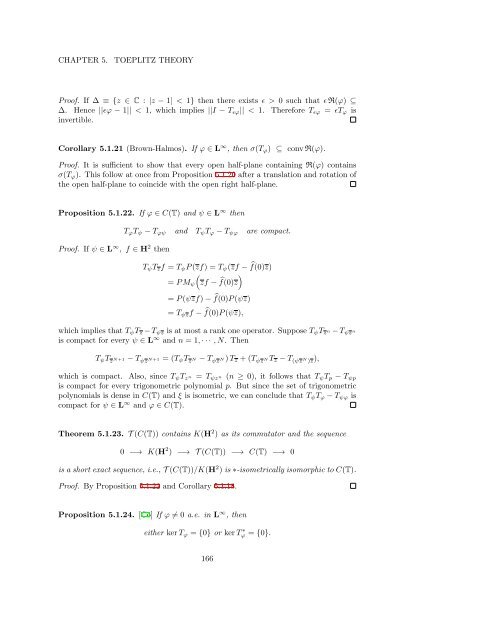Woo Young Lee Lecture Notes on Operator Theory
Woo Young Lee Lecture Notes on Operator Theory
Woo Young Lee Lecture Notes on Operator Theory
You also want an ePaper? Increase the reach of your titles
YUMPU automatically turns print PDFs into web optimized ePapers that Google loves.
CHAPTER 5.<br />
TOEPLITZ THEORY<br />
Proof. If ∆ ≡ {z ∈ C : |z − 1| < 1} then there exists ϵ > 0 such that ϵ R(φ) ⊆<br />
∆. Hence ||ϵφ − 1|| < 1, which implies ||I − T ϵφ || < 1. Therefore T ϵφ = ϵT φ is<br />
invertible.<br />
Corollary 5.1.21 (Brown-Halmos). If φ ∈ L ∞ , then σ(T φ ) ⊆ c<strong>on</strong>v R(φ).<br />
Proof. It is sufficient to show that every open half-plane c<strong>on</strong>taining R(φ) c<strong>on</strong>tains<br />
σ(T φ ). This follow at <strong>on</strong>ce from Propositi<strong>on</strong> 5.1.20 after a translati<strong>on</strong> and rotati<strong>on</strong> of<br />
the open half-plane to coincide with the open right half-plane.<br />
Propositi<strong>on</strong> 5.1.22. If φ ∈ C(T) and ψ ∈ L ∞ then<br />
Proof. If ψ ∈ L ∞ , f ∈ H 2 then<br />
T φ T ψ − T φψ and T ψ T φ − T ψφ are compact.<br />
T ψ T z f = T ψ P (zf) = T ψ (zf − ̂f(0)z)<br />
= P M ψ<br />
(zf − ̂f(0)z<br />
)<br />
= P (ψzf) − ̂f(0)P (ψz)<br />
= T ψz f − ̂f(0)P (ψz),<br />
which implies that T ψ T z − T ψz is at most a rank <strong>on</strong>e operator. Suppose T ψ T z n − T ψz n<br />
is compact for every ψ ∈ L ∞ and n = 1, · · · , N. Then<br />
T ψ T z N+1 − T ψz N+1 = (T ψ T z N − T ψz N ) T z + (T ψz N T z − T (ψz N )z),<br />
which is compact. Also, since T ψ T z n = T ψz n (n ≥ 0), it follows that T ψ T p − T ψp<br />
is compact for every trig<strong>on</strong>ometric polynomial p. But since the set of trig<strong>on</strong>ometric<br />
polynomials is dense in C(T) and ξ is isometric, we can c<strong>on</strong>clude that T ψ T φ − T ψφ is<br />
compact for ψ ∈ L ∞ and φ ∈ C(T).<br />
Theorem 5.1.23. T (C(T)) c<strong>on</strong>tains K(H 2 ) as its commutator and the sequence<br />
0 −→ K(H 2 ) −→ T (C(T)) −→ C(T) −→ 0<br />
is a short exact sequence, i.e., T (C(T))/K(H 2 ) is ∗-isometrically isomorphic to C(T).<br />
Proof. By Propositi<strong>on</strong> 5.1.22 and Corollary 5.1.18.<br />
Propositi<strong>on</strong> 5.1.24. [Co] If φ ≠ 0 a.e. in L ∞ , then<br />
either ker T φ = {0} or ker T ∗ φ = {0}.<br />
166













